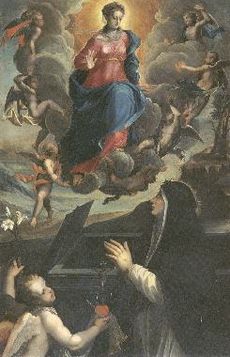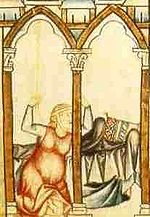- Osanna of Mantua
-
Osanna of Mantua 
L'Assunta con la Beata Osanna Andreasi by Ippolito AndreasiVirgin and Mystic Born 17 January 1449
Mantua, ItalyDied 1505 Honored in Roman Catholic Church Beatified 24 November 1694 by Pope Leo X and Pope Innocent XII Feast 18 June Attributes Dominican tertiary wearing a crown of thorns and surrounded by rays of light; Dominican with the devil under her feet; a broken heart with a crucifix springing from it; a lily; two angels, one with a lily, one with a cross Patronage school girls Blessed Osanna Andreasi of Mantua (also Hosanna and Andreassi) (Born 17 January 1449, Mantua, Italy - Died 1505 ) was a Dominican tertiary, stigmatic, and mystic.
Contents
Life
Osanna was the daughter of Italian nobles Niccolò Andreasi and Agnese Gonzaga.[1] She was reported to have had a vision of angels, paradise, and the Trinity at age five. Feeling called to religious life, she rejected a marriage arranged by her father. Unable to explain her attraction to religious life to her father, she secretly received the habit of the Dominican tertiaries. Returning home, she explained that she had made a vow and must wear it until she had fulfilled her promise.[2] She became a Dominican tertiary at 17. She waited 37 years to complete her vows so she could care for her brothers and sisters after the death of her parents.[3] A legend states that Osanna, like Saint Catherine, miraculously learned to read and write. One day she saw a piece of paper with two words and said, "Those words are 'Jesus' and 'Mary.'" Allegedly, from that time on, anything relating to the spiritual was within her grasp.[2]
When Osanna was thirty years old, she received stigmata on her head, her side, and on her feet. She also had a vision in which her heart was transformed and divided into four parts. For the rest of her life, she actively experienced the Passion, but in an especially intense way on Wednesdays and Fridays. Osanna confided these things in her biographer and "spiritual son," Father Jerome, as well as the fact that for years, she subsisted on practically no food at all.[4]
Osanna was a mystic who would fall into ecstasies whenever she spoke of God, and a visionary who saw images of Christ bearing his cross. She bore stigmata along with red marks, but there was no bleeding. She helped the poor and sick and served as spiritual director for many, spending much of her family's considerable fortune to help the unfortunate. She spoke out against decadence, and criticized the aristocracy for a lack of morality. She was a friend of Blessed Columba of Rieti, and is recorded to have sought counsel from Blessed Stephana de Quinzanis.[3]
Relationship with Girolamo de Monte Oliveto
Father Girolamo de Monte Oliveto (Jerome of Mount Olivet), was an Olivetan Benedictine. His vita of Blessed Osanna was written in 1507, very shortly after her death. Although Jerome noted that Osanna was not quick to discuss her spiritual experiences, in the last years of her life, she adopted Father Jerome as a "spiritual son," "conceived in the Blood of Christ."[4]
Jerome's account is especially unique due to his intimate relationship with his subject. The biography takes the form of a detailed report of his conversations with Osanna. Jerome appended to his account Latin translations of twenty-four letters from Osanna accompanied by documents certifying their authenticity.[4]
According to Father Benedict Ashley, O.P., these letters express an "intense and constant physical and inner suffering" made bearable only by "sublime experiences of union with God which [Osanna] cannot describe except in broken and inadequate language." A special source of misery for Osanna was the degradation of the Church under the abusive pontificate of Alexander VI.[4]
Veneration
By a papal brief of 8 January 1515 Leo X authorised the celebration of masses in honour of the beata Osanna in the state of Mantua. Her local cultus was confirmed by Innocent XII with a bull of 24 November 1694, and extended to the whole of the Dominican order two months later.[5][2]
References
- ^ It is unknown whether her mother was related to the Mantuan ruling family: see A. L. Redigonda, ‘Andreasi, Osanna’, Dizionario biografico degli italiani (DBI).
- ^ a b c Rabenstein, Katherine (June 1998). "Blessed Hosanna of Mantua, OP Tert. V (AC)". Saints O' the Day for July 18. Archived from the original on 2007-02-06. http://web.archive.org/web/20070206180037/http://www.saintpatrickdc.org/ss/0618.htm. Retrieved 2007-04-08.
- ^ a b Jones, Terry. "Osanna Andreasi". Patron Saints Index. Archived from the original on 2007-02-12. http://web.archive.org/web/20070212055949/http://www.catholic-forum.com/SAINTS/sainto05.htm. Retrieved 2007-04-08.
- ^ a b c d Ashley, Benedict. "Osanna d'Andreasi". Blessed Osanna d'Andreasi and Other Renaissance Italian Dominican Women Mystics. http://www.domcentral.org/study/ashley/osanna.htm. Retrieved 2007-04-11.
- ^ DBI.
External links
Categories:- 1449 births
- 1505 deaths
- People from Mantua
- Stigmatics
- Beatified people
- Members of the Dominican Order
- 16th-century venerated Christians
- Christian mystics
Wikimedia Foundation. 2010.

